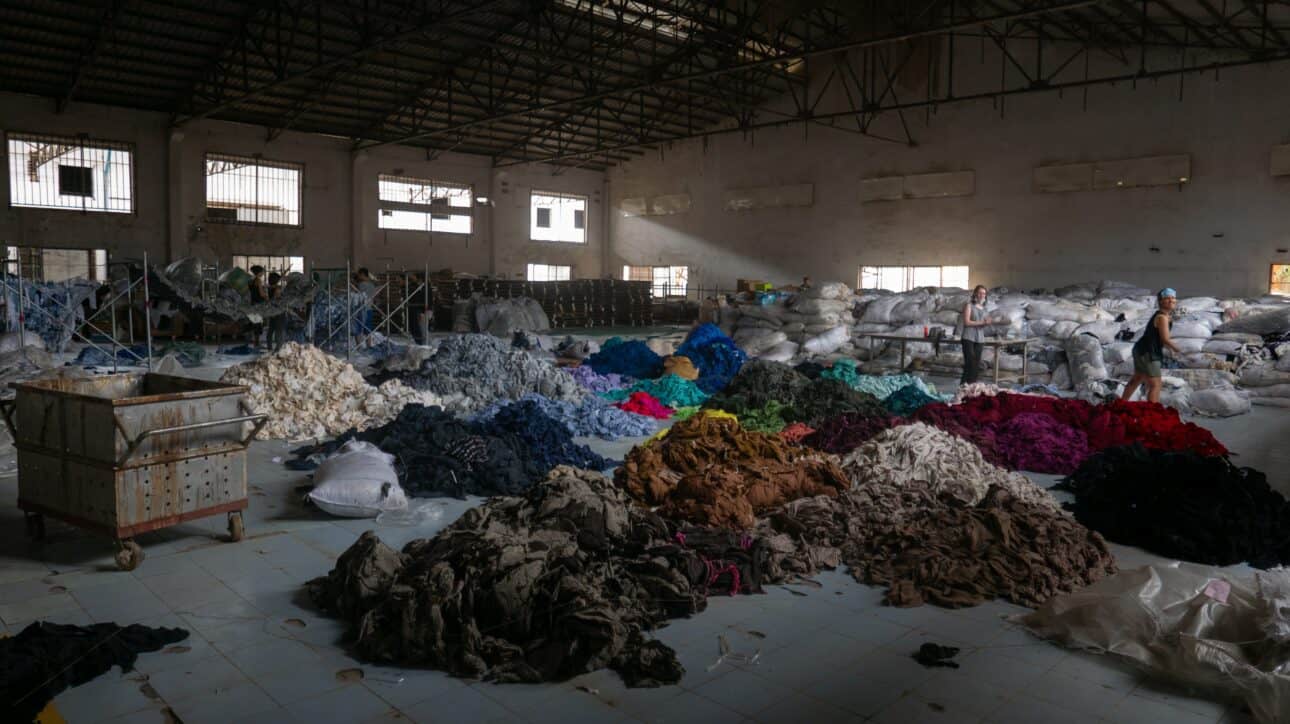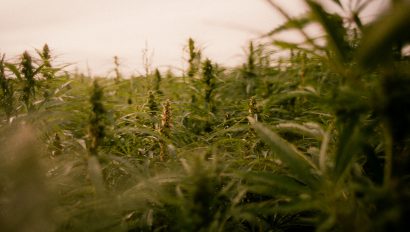Slowing Down Growth and Reimagining Value Creation with Rachel Arthur

Rachel Arthur is a consultant, speaker, and writer dedicated to actioning systems-level change within the fashion industry. She focuses on value chain transformation, narrative shift, and political advocacy in order to create a sector that is less harmful to people and planet.
Rachel is currently the advocacy lead for sustainable fashion at the United Nations Environment Programme, overseeing a strategy looking at the role of consumer-facing communication in the context of the triple planetary crisis. With a background as an award-winning business journalist, she has also contributed to titles as varied as Vogue Business, The Business of Fashion, The NY Times, Wired, Forbes, The Guardian, Wallpaper, and more.
As part of her work helping to build Textile Exchange’s strategy around slow growth, Rachel reflects on the urgent need for the fashion, textile, and apparel industry to rethink growth if it is to meet its climate targets on time. Here, she calls for an urgent revisitation of what we consider value, and a move away from growth based on exponential increases in production and consumption volume.
In 2019, the Global Fashion Agenda published its Pulse of the Fashion Industry report with a simple statement that transformed the way the industry should think about its sustainability work. “Fashion companies are not implementing sustainable solutions fast enough to counterbalance negative environmental and social impacts of the rapidly growing industry,” it read.
On its current trajectory, the industry today will still not transform in time for 2030, neither contributing to the intention of the Paris Agreement nor the UN Sustainable Development Goals. If it doesn’t change course, it will double the maximum required greenhouse gas emissions to stay on the 1.5°C pathway outlined by the Paris Agreement by 2030, where it should be looking to halve it, according to McKinsey & Co and Global Fashion Agenda.
Realizing that growth is impeding progress shows us how important it is to explore what true systems change looks like for the fashion sector. While emission reduction targets are crucial, we need a complete rethinking of what we consider value and a move away from growth based on exponential increases in production and consumption volume.
While emission reduction targets are crucial, we need a complete rethinking of what we consider value and a move away from growth based on exponential increases in production and consumption volume.
Although the exact facts are frequently debated and ultimately will remain unknown unless production numbers are reported by all companies, it is estimated the industry puts out somewhere in the region of 80-100 billion items of apparel and footwear every year. The Ellen MacArthur Foundation previously suggested production doubled between 2000 and 2015, while the number of times a garment was worn before being discarded decreased 36% during the same period.
This rapid increase is due to a rising global middle class, the growth of ultra-fast fashion, and an accepted narrative focused on newness and disposability. Yet to look at this through the lens of consumption alone is to place the onus on consumers for change; to suggest that reducing what we each as individuals buy is the way true transformation will occur.
In reality, it is the system itself that must shift. The degrowth movement – a word in itself that courts controversy due to the negative connotations it implies – is anchored in this sort of economic rethinking. “Slow growth,” as we’ll refer to it here, is not about cutting production volumes overnight, but about a controlled reduction to align output with planetary boundaries as well as a social foundation.
“Slow growth,” as we’ll refer to it here, is not about cutting production volumes overnight, but about a controlled reduction to align output with planetary boundaries as well as a social foundation.
One of the major things this calls for is a rethinking of Gross Domestic Product (GDP) as the primary measure of prosperity, and indeed progress, in the majority of economies around the world.
Even its creator, an economist named Simon Kuznets, when presenting the concept in the 1930s, warned GDP shouldn’t be used to determine success alone. In The Value of Everything, economist Mariana Mazzucato points out that the biggest challenge with GDP is how it makes no distinction between services that add value to the economy, and those that are dependent on extraction. If you pollute, GDP ultimately goes up, because someone is paid to clean up after you. Similarly, terrorism, war, crime, and cancer are all good for GDP.
Furthermore, what GDP is often forgetting is that by not considering the negative impacts of growth – such as the externalities of resource extraction – it doesn’t account for the potential worsening of the human condition in the future. A landmark review of The Economics of Biodiversity commissioned in the UK in 2019, and in turn The Report of the Brundtland Commission of 1987 on Environment and Development, focused on exactly this. Both refer to the idea that sustainable development has to mean leaving behind at least as large a stock of assets as that which it inherits – in other words, taking depreciation of natural capital into account, which GDP quite literally ignores.
“Arguably, the view of the economy as external to the environment may have been comparatively harmless so long as the biosphere was more than able to supply the demands humanity made of it. That simply is not the case any longer, and has not been for many decades,” Professor Sir Partha Dasgupta, economist and author of the report, explains.
In other words, growth is not only destroying the planet without compunction, but cannibalizing its own future. Right now, we are consuming Earth’s natural resources 1.75 times faster than it can regenerate them, according to the Global Footprint Network.
Arguably, the view of the economy as external to the environment may have been comparatively harmless so long as the biosphere was more than able to supply the demands humanity made of it. That simply is not the case any longer.
Yet tragically, many saw this coming. In 1972, a report called The Limits to Growth was released by The Club of Rome, an NGO comprised of scientists, economists, business leaders, and former politicians. Written by a group of researchers from the Massachusetts Institute of Technology, it examined the implications of continued worldwide growth taking into consideration population increase, agricultural production, non-renewable resource depletion, industrial output, and pollution generation – all of which the fashion industry in some way touches.
Using a computer model to crunch the numbers, it ultimately concluded that the earth cannot support such growth much beyond the end of the 21st Century, even with advanced technology. Based on tracking a business-as-usual plot line, the model showed “overshoot and collapse” by 2070.
As we know it today, the vast majority of growth and value creation in this industry is indeed tied to extracting from the earth in order to produce new products. It’s essential we start to scale business value opportunities outside of this old model. Reaching the sustainability targets of this industry will take a straight reduction in volume output based on virgin resources. Ultimately, this means the goals of the system need to change.
The World Resources Institute (WRI) calls this the Elephant in the Boardroom; uncomfortable and unmentioned because it challenges the entire business model as it stands. But the planet’s natural systems and finite resources cannot keep up, which means growth predicated on unchecked consumption is no longer an option, it explains. It calls instead for the pursuit of new business models that allow growth within the planet’s limits and generate stakeholder value in new and exciting ways.
Reaching the sustainability targets of this industry will take a straight reduction in volume output based on virgin resources. Ultimately, this means the goals of the system need to change.
Fashion’s growth was confronted at the Textile Exchange conference in 2021, in a keynote address given by Jason Hickel, economic anthropologist and author of Less is More: How Degrowth Will Save the World. Referring to the industry as a textbook example of what is wrong with the economy, he explained how focusing on efficiencies is not going to cut it alone, noting that to actively achieve the climate targets set out before us, we need to scale down aggregate textile production.
The greenhouse gas (GHG) emissions modeling conducted by Textile Exchange backs up this point. Even in a scenario in which substitution of materials to preferred options is aggressively and rapidly occurring, the fashion, textile, and apparel industry will not meet its 2030 target of 45% GHG emissions reduction in raw materials sourcing unless overall growth rates are also reduced.
What’s key here is that organizations, and the industry at large, see absolute reduction in their emissions, whereby total emissions (and resource extraction) are reduced irrespective of company growth. This is compared to relative reductions, whereby emissions intensity might fall as new efficiencies and technologies are employed, but the total volume of emissions still increases as the business grows. When we talk about decoupling value creation from resource extraction, it is only absolute decoupling that matters.
This is something luxury group Kering recently committed to – reducing its absolute greenhouse gas emissions across its businesses by 40% by 2035 on a 2021 baseline. Or, in other words, aiming to reduce the volume of its total emissions no matter how much it grows. In contrast, previous company reporting showed that while it reduced its footprint by 12% in 2018 as a proportion of revenue compared to a year earlier, on an absolute basis, that reduction was fully offset by the company’s growth. Its progress was thus “limited by its success,” reported The Business of Fashion.
Of its recent commitment, Kering chairman and CEO François-Henri Pinault, said: “If we want to truly decarbonize our global businesses, we need to move from carbon intensity reductions to absolute reductions. I am convinced that impact reduction in absolute terms combined with value creation must be the next horizon for truly sustainable companies.”
How it is going to do so is yet to be seen, but Kering has nodded towards things like scaling repair and resale services, material innovation, and upcycling.
If we want to truly decarbonise our global businesses, we need to move from carbon intensity reductions to absolute reductions.
Ralph Lauren has similarly previously spoken about how it can achieve “financial growth through degrowth of resources,” or in other words, producing less new product, while continuing to make a profit. Both Ralph Lauren and Kering refer to increasing their understanding of inventory to ensure less overproduction and wasted product.
On the consumption side of things, Selfridges is also interesting to consider. In 2022, it committed to a target to have 45% of transactions across its stores and online to come from circular products and services by 2030, compared to less than 1% today.
Increasing revenue share from circular business models and processes is crucial to achieve a decoupling of value creation and resource extraction. While numerous fashion brands have been launching all manner of circular solutions seemingly aligned with this thinking, we’re not yet at a point where any of them are able to show that doing so has replaced any significant percentage of new product creation.
Increasing revenue share from circular business models and processes is crucial to achieve a decoupling of value creation and resource extraction.
Perhaps what’s key at Kering, is that efforts towards absolute decoupling are also being anchored by a new sustainable finance department, which will “follow in depth the decarbonization roadmap and everything linked with our strategy, and to be sure that business and sustainability go hand in hand.” This sort of systems thinking, with new value creation baked into the structure of the organization, is what it will take for success.
At the Textile Exchange conference in 2022, a dedicated session on this topic identified the need to redefine value as an industry accordingly. A key suggestion was for a framework to help track, manage and set goals for absolute decoupling, and to create incentives to help drive this change. This must also focus on ensuring any efforts towards slowing growth understand potential trade-offs and enable a just transition.
Textile Exchange is working on a strategy to articulate its role in supporting the industry on this topic, with the intention to share it later this year. It is keen to gain (confidential) inputs on the topic and is currently gathering expressions of interest. Please contact beth@textileexchange.org if you would like to share your thoughts.


